By Tim Waterson
Most drummers are capable of producing a short blast of speed with their bass drums by tensing up the twitch muscles in the ankles. Unfortunately, this produces an uneven sound after a few seconds and could result in tissue damage because of the tense motion used.
In this article I focus on the mechanics involved in playing fast with your feet. I would like to stress the importance of playing relaxed—this will allow you to achieve a smoother sound. The smoother you play, the easier it will be to achieve a higher rate of speed.
Let’s start with your posture. Try sitting on your drum throne with your legs shoulder-length apart. Sit with your legs parallel to the floor so that your ankles are under your knees. Keep your back straight. Strive for good posture without being too stiff.
When you play your bass drums or double pedal, try experimenting with different drum throne heights and distance between your pedals. For the angle of the pedals, 45-degrees seems to be a good starting point. See what works for you, as we are all individuals. Try shifting your weight to the front of your drum seat and allow your thighs the freedom to move. When your thighs come into contact with the drum seat it tends to slow you down.
I have found the following exercises useful in gaining speed and endurance with your feet.
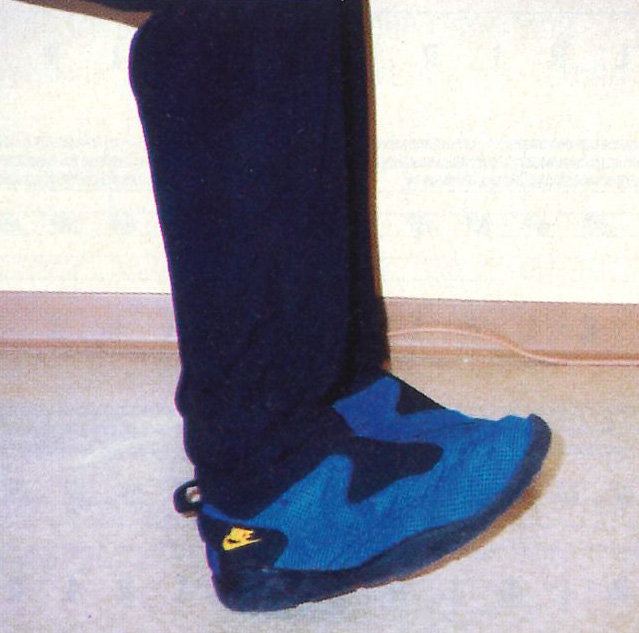
Heel-down drum foot technique
Heel-Down. By playing this way, you are able to stretch and work the muscles in the front part of your calf. Place your feet on the floor in front of you and lift your soles in the air. Try stretching upwards until you feel a slight tensioning in the muscle, then put your foot down. Repeat in a slow RLRL pattern. Try to stretch each day and play a little faster.
Be careful not to over-stretch the muscles. Try playing rhythmic patterns as you would with your hands. The main idea of this exercise is to warm up the muscles and allow you to feel the motion in your feet and ankles of singles, doubles, flams and anything else you want to play with your feet.
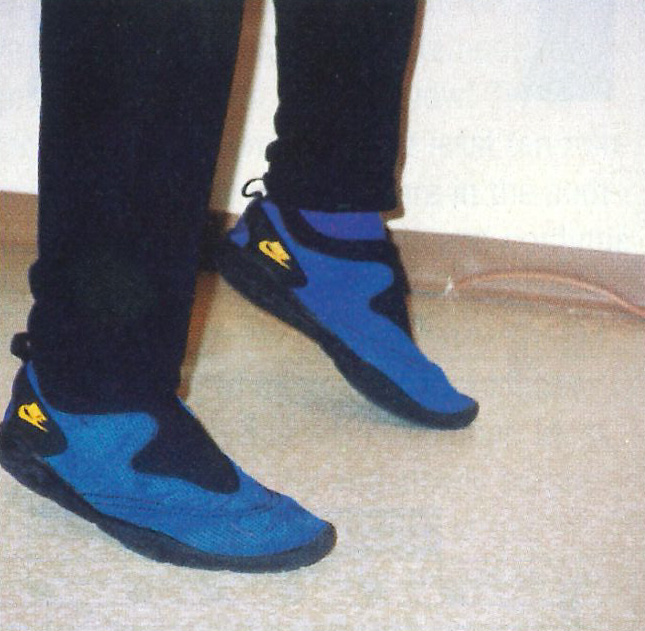
Heel-up drum foot technique
Heel-Up. With your legs in the same position, slowly lift your heel off the floor until you feel a slight tension in the back of your calf muscle. This time bring your heel down, but don’t let it hit the floor. Allow your heel to bounce a couple inches off the floor. This motion will simulate playing on your pedals and allow you to stretch the muscles in the back of your calf.
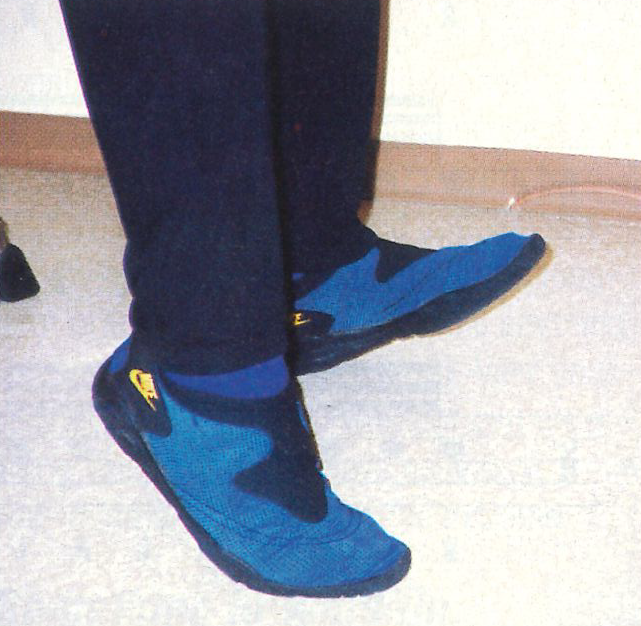
Heel-toe drum foot technique
Heel-Toe. By combining heel-up and heel-down, you will introduce yourself to the heel-toe technique. This time bring your heel down on the floor, and as your heel hits, bring your toes and sole of your foot up. Then bring your toes down and your heel up to produce a rocking motion between the heel and toe. In this exercise I emphasize learning the motion and stretching the muscles. The more you do this, the easier the speed will develop.
On the Drum Set. Let’s try playing eighth-notes heel-down with our right foot for four bars, then with our left foot heel-down for four bars. In order to play sixteenth-notes on our bass drums with two feet at 200 bpm, we must be able to play eighth-notes with both our right and left feet individually at 200 bpm. Practice with a metronome and slowly build up your speed over time. After you have built up your desired speed (as fast as you can maintain heel-down) try measuring yourself on the Drumometer.
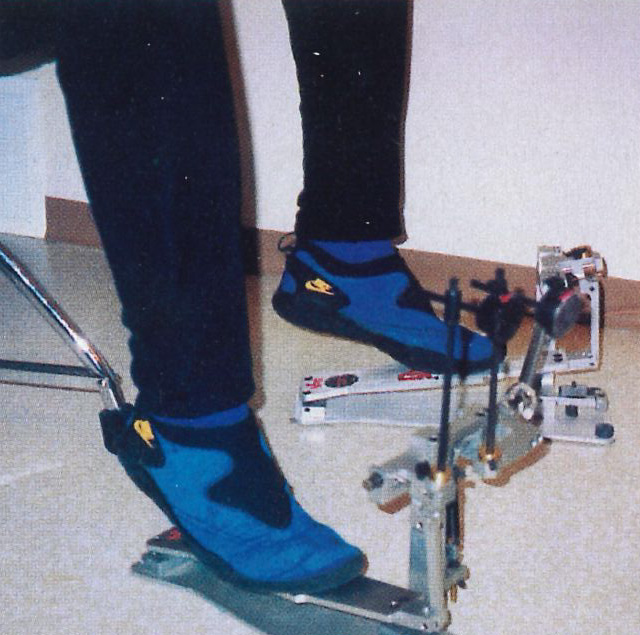
Heel-up drum foot technique on pedals
Heel-Up on Your Pedals. First let’s find the sweet spot on your pedalboard. This is the spot on the pedal where the least amount of effort is required to produce the greatest amount of continual motion. Once you find the sweet spot, place the sole of your foot there and lift your heel off the footplate. Push down on the pedalboard with your foot and be sure not to lock your ankles, as this produces unnecessary tension. Remember to let your ankle bounce in the air and try not to lift your soles off the pedalboard. Practice playing quarter-notes, alternating RLRL with your feet. Work up to eighth-notes, eighth-note triplets, sixteenth-notes and sixteenth-note triplets.
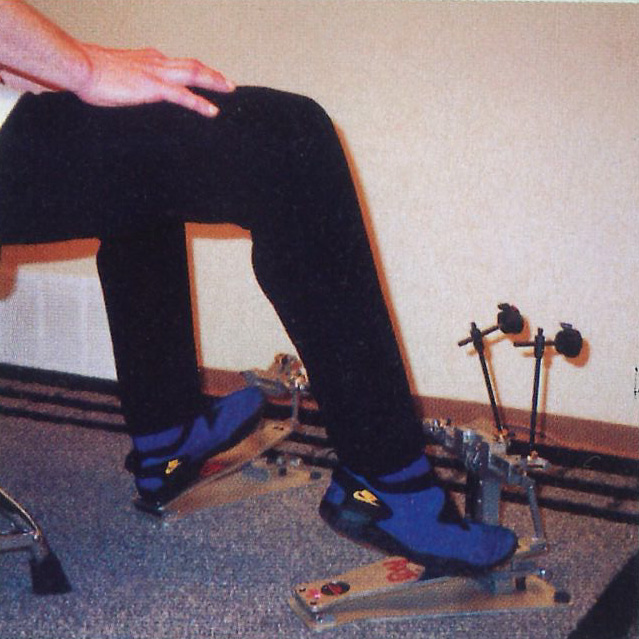
Heel-toe drum foot technique on pedals
Heel-Toe Doubles. This technique has been around for a long time and is the easiest motion when you are playing fast, as you are able to produce two notes with one motion. By hitting the pedal with your heel on the down-stroke and the toe with the upstroke, you are able to produce double stroke rolls with your feet.
You will notice that when you play heel-up, your heel naturally comes down almost to the pedalboard. If you let your heel come down first and let the motion roll from your heel to the toe, you will be able to increase your speed quite a lot. Many hand drummers use this technique as well, as they roll notes between their palm and fingers.
Try experimenting with different bass drum beaters. I have found that using wood with a tight bass drumhead allows for a quick response when playing double strokes with your feet. Remember that if you play relaxed, you should be able to play any speed you desire for as long as you want—hopefully to a very old age.
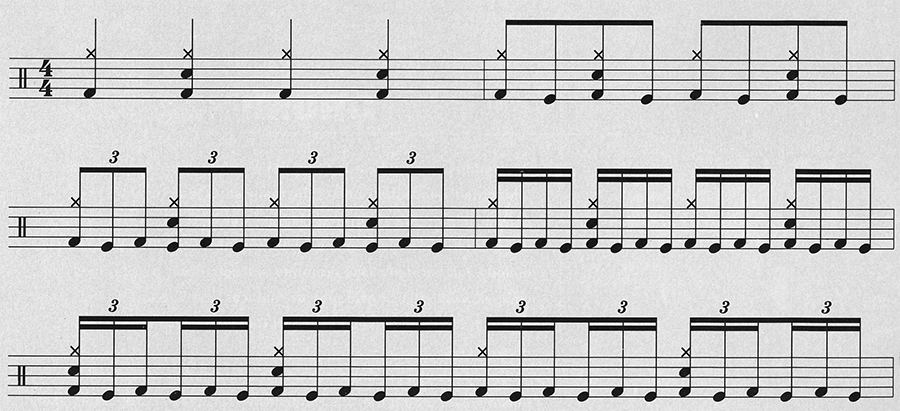
Drum foot technique exercises
This article originally appeared in the Feb/Mar 2001 issue of Drum! magazine
Extreme Sports Drumming: Mangini, Donati, Morgenstein Weigh in on the Quest for Speed
